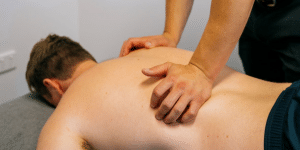Ankle Taping Vs Bracing: Which is Better?

Hundreds of Australians sprain their ankle ligaments every day. They’re one of the most common sports injuries but also occur during everyday activities, especially on uneven surfaces or going downstairs.
Treating acute ankle sprains is a whole topic on its own, but prevention of recurring injury is a big part of successful treatment. We know that even after the pain and swelling has settled, many people are susceptible to re-injury, so it’s important to offer additional stability when they return to sport.
There are two main methods of reinforcing ankle ligaments, each with their own pros and cons.
The first: rigid sports tape. It is not to be confused with the new craze of stretchy k-tapes, and is a beige or white colour and hand tearable. Applied correctly, sports tape supplements the ankle ligaments (stiff tissues that prevent excessive joint movement).
If you haven’t already, watching our how-to video of ankle taping will give you a good idea how to go about it. Remember to remove any leg hair first!

Ankle taping is a great way to give the ankle more stability when returning to sport from an ankle injury. There are a number of different techniques which can be used depending on what ligaments have been injured and the type of activity, so it is strongly suggested you consult your physiotherapist to learn the best approach for you. Bring your phone and take a video that you can refer to at home!
Advantages of taping | Disadvantages of taping |
| Effective | Repeated applications become costly |
| Generally more comfortable in the short term | Higher risk of skin irritation, especially with longer term use |
| Cheaper in the short term | Requires someone else to apply (or a lot of practice to effectively do it yourself |
| No extra bulk, meaning it’s a practical solution even in the tightest shoes | Requires good technique; if too tight or too loose, you need to start again |
| Men will have to shave their ankles and lower legs some people may find this a positive! |

The second method is ankle bracing: the use of a pre-fabricated ankle sleeve with adjustable straps. Good braces mimic the effect of taping and are easily applied yourself. These are especially good when there is chronic ankle instability and the use of tape over and over again can become uncomfortable and expensive. We supply a high quality brand (the ASO ankle brace) which comes in black or white and does a great job at preventing injury and stabilising the ankle joints.
Advantages of ankle bracing | Disadvantages of ankle bracing |
| Much cheaper in the long term | More people find bracing uncomfortable |
| Easier to apply with no assistance required | Bulkier – it’s hard to get into a tightly fitted football boot with a brace. Netball, tennis, running or work shoes are all generally fine. |
| Easy to tighten or loosen as needed | More expensive in the short term |
| Less skin irritation | |
| Don’t need to shave |
So which is best?
The answer, as usual, is that it depends!
Studies either have found no difference or a superior effect from bracing compared with taping.
Our expert opinion and experience would suggest:
- Ankle bracing is the only option for people with a tape allergy or frail skin at risk of damage from the strong adhesive.
- If tape is well tolerated, there’s someone to help you apply it properly, and you are only likely to need extra support in the short term, tape is probably the most comfortable and cost effective option for you.
- If you need the additional support over a longer period (e.g. a whole netball season, or every day for a month at work) and you can find a comfortable brace that fits in your shoes, ankle bracing will be a more comfortable and cost effective option.
There are lots of other variables, such as the level of instability, exact area of injury, and type of activity. It is also very important to note that repeat ankle sprains are much more common without proper rehabilitation and you should not rely on bracing/taping alone. The results we often see from patients with acute and chronic instability not only surprises us but the patient also. The main components of a rehabilitation program include range of motion, strengthening, balance and proprioceptive exercises, as well as proper acute management which can sometimes include CAM boots and crutches depending on the severity and ligament injured.
If you have any questions or have an ankle injury that needs physiotherapy, contact us here or book an appointment online






